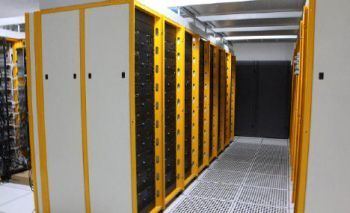 | ||
PARAM is a series of supercomputers designed and assembled by the Centre for Development of Advanced Computing (C-DAC) in Pune, India. The latest machine in the series is the PARAM ISHAN.
Contents
- History
- PARAM 8000
- PARAM 8600
- PARAM 9900SS
- PARAM 10000
- PARAM Padma
- PARAM Yuva
- Further developments
- Param Yuva II
- PARAMNet
- Operators
- References
Param means supreme in Sanskrit.
History
After being denied Cray supercomputers as a result of a technology embargo, India started a program to develop indigenous supercomputers and supercomputing technologies. Supercomputers were considered a double edged weapon capable of assisting in the development of nuclear weapons. For the purpose of achieving self-sufficiency in the field, the Centre for Development of Advanced Computing (C-DAC) was set up in 1988 by the then Department of Electronics with Dr. Vijay Bhatkar as its Director. The project was given an initial run of 3 years and an initial funding of ₹ 300,000,000, the same amount of money and time that was usually expended to purchase a supercomputer from the US. In 1990, a prototype was produced and was benchmarked at the 1990 Zurich Supercomputering Show. It surpassed most other systems, placing India second after US.
The final result of the effort was the PARAM 8000, which was installed in 1991.
PARAM 8000
Unveiled in 1991, PARAM 8000 used Inmos T800 transputers. Transputers were a fairly new and innovative microprocessor architecture designed for parallel processing at the time. It was a distributed memory MIMD architecture with a reconfigurable interconnection network. It had 64 CPUs. Exported to Germany, UK and Russia.
PARAM 8600
PARAM 8600 was an improvement over PARAM 8000. It was a 256 CPU computer. For every four Inmos T800, it employed an Intel i860 coprocessor. The result was over 5 GFLOPS at peak for vector processing. Several of these models were exported.
PARAM 9900/SS
PARAM 9900/SS was designed to be a MPP system. It used the SuperSPARC II processor. The design was changed to be modular so that newer processors could be easily accommodated. Typically, it used 32-40 processors. But, it could be scaled up to 200 CPUs using the clos network topology. PARAM 9900/US was the UltraSPARC variant and PARAM 9900/AA was the DEC Alpha variant.
PARAM 10000
In 1998, the PARAM 10000 was unveiled. PARAM 10000 used several independent nodes, each based on the Sun Enterprise 250 server and each such server contained two 400Mhz UltraSPARC II processors. The base configuration had three compute nodes and a server node. The peak speed of this base system was 6.4 GFLOPS. A typical system would contain 160 CPUs and be capable of 100 GFLOPS But, it was easily scalable to the TFLOP range. Exported to Russia and Singapore.
PARAM Padma
PARAM Padma (Padma means Lotus in Sanskrit) was introduced in April 2003. It had a peak speed of 1024 GFLOPS (about 1 TFLOP) and a peak storage of 1 TB. It used 248 IBM Power4 CPUs of 1 GHz each. The operating system was IBM AIX 5.1L. It used PARAMnet II as its primary interconnect. It was the first Indian supercomputer to break the 1 TFLOP barrier.
PARAM Yuva
PARAM Yuva (Yuva means Youth in Sanskrit) was unveiled in November 2008. It has a maximum sustainable speed (Rmax) of 38.1 TFLOPS and a peak speed (Rpeak) of 54 TFLOPS. There are 4608 cores in it, based on Intel 73XX of 2.9 GHz each. It has a storage capacity of 25 TB up to 200 TB. It uses PARAMnet 3 as its primary interconnect.
Further developments
In July 2009, it was announced that C-DAC was developing a new high-speed PARAM. It was expected to be unveiled by 2012 and was expected to break the 1 PetaFLOPS barrier. In November 2014 it was reported that India is working on the Fastest supercomputer ever which is set to work at 132 Exaflops per second.
Param Yuva II
Param Yuva II was made by Centre for Development of Advanced Computing in a period of three months, at a cost of ₹16 crore (US$2 million), and was unveiled on 8 February 2013. It performs at a peak of 524 teraflops and consumes 35% less energy as compared to Param Yuva. It delivers sustained performance of 360.8 teraflops on the community standard Linpack benchmark, and would have been ranked 62 in the November 2012 ranking list of Top500. In terms of power efficiency, it would have been ranked 33rd in the November 2012 List of Top Green500 supercomputers of the world. It is the first Indian supercomputer achieving more than 500 teraflops.
Param Yuva II will be used for research in space, bioinformatics, weather forecasting, seismic data analysis, aeronautical engineering, scientific data processing and pharmaceutical development. Educational institutes like the Indian Institutes of Technology and National Institutes of Technology can be linked to the computer through the national knowledge network. This computer is a stepping stone towards building the future petaflop-range supercomputers in India.
PARAMNet
PARAMNet is a high speed high bandwidth low latency network developed for the PARAM series. The original PARAMNet used an 8 port cascadable non-blocking switch developed by C-DAC. Each port provided 400 Mb/s in both directions (thus 2x400 Mbit/s) as it was a full-duplex network. It was first used in PARAM 10000.
PARAMNet II, introduced with PARAM Padma, is capable of 2.5 Gb/s while working full-duplex. It supports interfaces like Virtual Interface Architecture and Active messages. It uses 8 or 16 port SAN switches. The grid computing network GARUDA is also based on it.
Operators
PARAM supercomputers are used by both public and private operators for various purposes. As of 2008, 52 PARAMs have been deployed. Of these, 8 are located in Russia, Singapore, Germany and Canada. PARAMs have also been sold to Tanzania, Armenia, Saudi Arabia, Singapore, Ghana, Myanmar, Nepal, Kazakhstan, Uzbekistan, and Vietnam.
